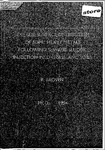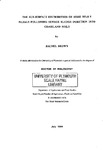THE SUB-SURFACE DISTRIBUTION OF SOME HEAVY METALS FOLLOWING SEWAGE SLUDGE INJECTION INTO GRASSLAND SOILS
| dc.contributor.author | BROWN, RACHEL | |
| dc.contributor.other | School of Geography, Earth and Environmental Sciences | en_US |
| dc.date.accessioned | 2012-08-02T10:24:57Z | |
| dc.date.available | 2012-08-02T10:24:57Z | |
| dc.date.issued | 1994 | |
| dc.identifier | Not available | en_US |
| dc.identifier.uri | http://hdl.handle.net/10026.1/1077 | |
| dc.description | Merged with duplicate record 10026.1/2079 on 06.20.2017 by CS (TIS) | |
| dc.description.abstract |
The use of suitable sewage sludge in agriculture is currently its cheapest disposal option,, both in terms of monetary cost, resource utilisation and environmental impact Monitoring of die heavy metal content of the soil after sludge application is required by European Council Du-ective 86/278/EEC, and whilst the behaviour of metals from surface-applied sludge is well documented, the behaviour following other methods of application has received litde attention. The most important alternative land application method cturentiy in use is the subsurface injection of sludge. In this project, field- and laboratory-based experiments were set up to describe the postinjection disttibution of Cd, Cu, Ni, Pb and Zn and the effect on this of: tine design (using die straight tine, side-inclined tine and winged tine), rate of injection (225 m^ ha'-^ and 300 m3 ha"-^), and soil factors ^ H , cation exchange capacity, organic carbon, percentage clay,. Fe and Mn concentration, and redox potential). An assessment of the variability of die injection operation was also important, as account needs to be made of metal distribution and variability in order to delimit an appropriate sampling regime. The results of these experiments indicated that Cu, Pb and Zn are basically immobile, remaining widiin 120 mm of die centte of die original slot location. Tine design was seen to have a significant influence on the pattern of subsurface metal distribution, but neither this,' rate of injection nor soil factors adequately predicted die extent of diis distiibution. Instead, metal identity and concentration widiin the sludge were identified as the most influential factors, in that appreciable quantities of Cd and Ni are leached out of the profile to distances exceeding 300 mm from die sludge, and greater metal concentirations (of the remaining metals) in the injected sludge create distinct gradients in the soil and saturates exchange sites, thus promoting mobility via diffusion, over-riding normal metal chemistry. Of those measured variables that had a secondary effect on distribution, pH, Fe oxide concentration and percentage clay were identified as the most important soil factors.The winged tine was seen to promote soil disturbance and hence metal distribution, and the paraplow to restrict both. In practical terms, these conclusions indicate that the current sampling protocol is inadequate. An alternative regime is suggested. | en_US |
| dc.description.sponsorship | The Water Research Centre | |
| dc.description.sponsorship | Seale-Hayne Faculty of Agriculture, Foodand Land'Use; The Water Research Centre | en_US |
| dc.language.iso | en | en_US |
| dc.publisher | University of Plymouth | en_US |
| dc.title | THE SUB-SURFACE DISTRIBUTION OF SOME HEAVY METALS FOLLOWING SEWAGE SLUDGE INJECTION INTO GRASSLAND SOILS | en_US |
| dc.type | Thesis | |
| dc.identifier.doi | http://dx.doi.org/10.24382/4565 | |
| dc.identifier.doi | http://dx.doi.org/10.24382/4565 |
Files in this item
This item appears in the following Collection(s)
-
01 Research Theses Main Collection
Research Theses Main



